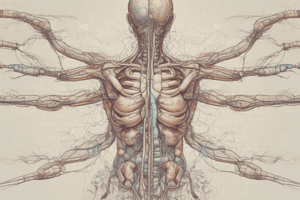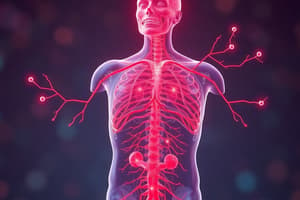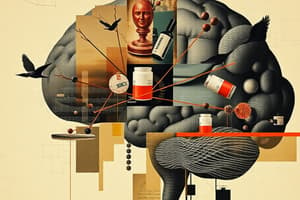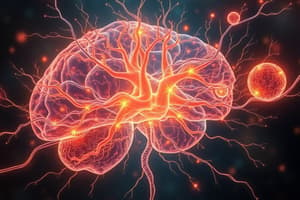Podcast
Questions and Answers
A drug that stimulates α2 receptors would likely cause which of the following effects?
A drug that stimulates α2 receptors would likely cause which of the following effects?
- Increased digestive activity
- Bronchodilation
- Increased heart rate
- Inhibition of neurotransmitter release (correct)
Which of the following scenarios would predominantly activate the parasympathetic nervous system?
Which of the following scenarios would predominantly activate the parasympathetic nervous system?
- Digesting a meal (correct)
- Experiencing extreme cold
- Facing a sudden threat
- Engaging in intense physical exercise
Which neurotransmitter is primarily responsible for the effects of the sympathetic nervous system on target tissues?
Which neurotransmitter is primarily responsible for the effects of the sympathetic nervous system on target tissues?
- Acetylcholine (ACh)
- Dopamine
- Norepinephrine (NE) (correct)
- Serotonin
A medication that blocks muscarinic receptors would most likely have which of the following effects?
A medication that blocks muscarinic receptors would most likely have which of the following effects?
Which of the following is a characteristic of nicotinic receptors?
Which of the following is a characteristic of nicotinic receptors?
Activation of β2 receptors in the lungs would result in which of the following physiological responses?
Activation of β2 receptors in the lungs would result in which of the following physiological responses?
Which of the following best describes the function of the adrenal medulla in the sympathetic nervous system?
Which of the following best describes the function of the adrenal medulla in the sympathetic nervous system?
Where do preganglionic neurons of the parasympathetic nervous system originate?
Where do preganglionic neurons of the parasympathetic nervous system originate?
Which of the following physiological responses is NOT typically associated with parasympathetic nervous system activation?
Which of the following physiological responses is NOT typically associated with parasympathetic nervous system activation?
A patient is experiencing urinary retention. Which type of drug might be prescribed to help alleviate this condition?
A patient is experiencing urinary retention. Which type of drug might be prescribed to help alleviate this condition?
Which type of receptor is stimulated by acetylcholine (ACh) released from preganglionic neurons in both the sympathetic and parasympathetic nervous systems?
Which type of receptor is stimulated by acetylcholine (ACh) released from preganglionic neurons in both the sympathetic and parasympathetic nervous systems?
A patient is given a medication that blocks the reuptake of norepinephrine. What overall effect would this medication have on the sympathetic nervous system?
A patient is given a medication that blocks the reuptake of norepinephrine. What overall effect would this medication have on the sympathetic nervous system?
Which of the following is a direct-acting cholinergic agonist?
Which of the following is a direct-acting cholinergic agonist?
A patient with hypertension is prescribed a beta-blocker. Which specific effect of the beta-blocker contributes to lowering blood pressure?
A patient with hypertension is prescribed a beta-blocker. Which specific effect of the beta-blocker contributes to lowering blood pressure?
Which of the following is NOT a typical clinical use for adrenergic agonists?
Which of the following is NOT a typical clinical use for adrenergic agonists?
A patient is experiencing bradycardia (slow heart rate). Which of the following medications might be administered to increase their heart rate?
A patient is experiencing bradycardia (slow heart rate). Which of the following medications might be administered to increase their heart rate?
Why might a non-selective beta-blocker be contraindicated in a patient with asthma?
Why might a non-selective beta-blocker be contraindicated in a patient with asthma?
A surgeon needs to induce muscle relaxation in a patient during a surgical procedure. Which type of drug would be most appropriate for this purpose?
A surgeon needs to induce muscle relaxation in a patient during a surgical procedure. Which type of drug would be most appropriate for this purpose?
Flashcards
Pharmacology
Pharmacology
Study of drugs and their effects on living systems.
Autonomous Nervous System (ANS)
Autonomous Nervous System (ANS)
Regulates involuntary physiological processes (e.g., heart rate, digestion).
Sympathetic Nervous System
Sympathetic Nervous System
"Fight or flight" system; prepares the body for action.
Parasympathetic Nervous System
Parasympathetic Nervous System
Signup and view all the flashcards
Acetylcholine (ACh)
Acetylcholine (ACh)
Signup and view all the flashcards
Norepinephrine (NE)
Norepinephrine (NE)
Signup and view all the flashcards
Cholinergic Receptors
Cholinergic Receptors
Signup and view all the flashcards
Adrenergic Receptors
Adrenergic Receptors
Signup and view all the flashcards
Preganglionic Neuron Neurotransmitter
Preganglionic Neuron Neurotransmitter
Signup and view all the flashcards
Postganglionic Neuron Neurotransmitter
Postganglionic Neuron Neurotransmitter
Signup and view all the flashcards
Drugs Affecting the ANS
Drugs Affecting the ANS
Signup and view all the flashcards
Cholinergic Agonists
Cholinergic Agonists
Signup and view all the flashcards
Cholinergic Antagonists
Cholinergic Antagonists
Signup and view all the flashcards
Adrenergic Agonists
Adrenergic Agonists
Signup and view all the flashcards
Adrenergic Antagonists
Adrenergic Antagonists
Signup and view all the flashcards
Direct-Acting Cholinergic Agonists
Direct-Acting Cholinergic Agonists
Signup and view all the flashcards
Indirect-Acting Cholinergic Agonists
Indirect-Acting Cholinergic Agonists
Signup and view all the flashcards
Adrenergic Antagonists Action
Adrenergic Antagonists Action
Signup and view all the flashcards
Study Notes
- Pharmacology is the study of drugs and their effects on living systems.
- The autonomous nervous system (ANS) regulates involuntary physiological processes.
- The ANS controls heart rate, blood pressure, digestion, and other functions.
- The ANS consists of two main branches: the sympathetic and parasympathetic nervous systems.
- The sympathetic nervous system is often referred to as the "fight or flight" system.
- The parasympathetic nervous system is often referred to as the "rest and digest" system.
Neurotransmitters of the ANS
- Acetylcholine (ACh) and norepinephrine (NE) are the primary neurotransmitters in the ANS.
- ACh is the primary neurotransmitter in the parasympathetic nervous system.
- NE is the primary neurotransmitter in the sympathetic nervous system.
- Some sympathetic neurons release ACh instead of NE.
- Dopamine, another catecholamine, also functions as a neurotransmitter in the sympathetic nervous system.
- Neurotransmitters bind to specific receptors on target tissues to produce their effects.
ANS Receptors
- Cholinergic receptors bind acetylcholine.
- Adrenergic receptors bind norepinephrine and epinephrine.
- Cholinergic receptors are divided into nicotinic and muscarinic receptors.
- Nicotinic receptors are ligand-gated ion channels and respond rapidly.
- Muscarinic receptors are G protein-coupled receptors (GPCRs) and have slower effects.
- Adrenergic receptors are divided into alpha (α) and beta (β) receptors.
- Alpha and beta receptors are GPCRs.
- α1 receptors generally cause vasoconstriction and smooth muscle contraction.
- α2 receptors are located presynaptically and inhibit further neurotransmitter release.
- β1 receptors primarily increase heart rate and contractility.
- β2 receptors cause bronchodilation and smooth muscle relaxation.
- β3 receptors are involved in lipolysis.
Sympathetic Nervous System
- Preganglionic neurons originate in the thoracic and lumbar regions of the spinal cord.
- Preganglionic neurons release ACh, which stimulates nicotinic receptors on postganglionic neurons.
- Postganglionic neurons release NE, which stimulates adrenergic receptors on target tissues.
- The adrenal medulla is a modified sympathetic ganglion that releases epinephrine and norepinephrine into the bloodstream.
- Sympathetic activation leads to increased heart rate, increased blood pressure, bronchodilation, and decreased digestive activity.
Parasympathetic Nervous System
- Preganglionic neurons originate in the brainstem and sacral spinal cord.
- Preganglionic neurons release ACh, which stimulates nicotinic receptors on postganglionic neurons.
- Postganglionic neurons release ACh, which stimulates muscarinic receptors on target tissues.
- Parasympathetic activation leads to decreased heart rate, decreased blood pressure, bronchoconstriction, and increased digestive activity.
Drugs Affecting the ANS
- Drugs can affect the ANS by mimicking or blocking the actions of neurotransmitters.
- Cholinergic agonists (parasympathomimetics) increase the activity of the parasympathetic nervous system.
- Cholinergic antagonists (parasympatholytics) decrease the activity of the parasympathetic nervous system.
- Adrenergic agonists (sympathomimetics) increase the activity of the sympathetic nervous system.
- Adrenergic antagonists (sympatholytics) decrease the activity of the sympathetic nervous system.
Cholinergic Agonists
- Direct-acting cholinergic agonists bind directly to cholinergic receptors.
- Indirect-acting cholinergic agonists inhibit the breakdown of ACh, increasing its concentration in the synapse.
- Examples of direct-acting cholinergic agonists include pilocarpine and bethanechol.
- Examples of indirect-acting cholinergic agonists include physostigmine and neostigmine.
- Cholinergic agonists can be used to treat glaucoma, urinary retention, and myasthenia gravis.
Cholinergic Antagonists
- Cholinergic antagonists block the action of ACh at cholinergic receptors.
- Atropine is a muscarinic antagonist that is used to treat bradycardia and to dilate the pupils.
- Scopolamine is a muscarinic antagonist that is used to prevent motion sickness.
- Ipratropium is a muscarinic antagonist that is used to treat bronchospasm.
- Neuromuscular blocking agents, such as succinylcholine and tubocurarine, block nicotinic receptors at the neuromuscular junction and are used to produce muscle relaxation during surgery.
Adrenergic Agonists
- Direct-acting adrenergic agonists bind directly to adrenergic receptors.
- Indirect-acting adrenergic agonists increase the release or block the reuptake of norepinephrine.
- Examples of direct-acting adrenergic agonists include epinephrine, norepinephrine, and isoproterenol.
- Examples of indirect-acting adrenergic agonists include amphetamine and cocaine.
- Adrenergic agonists can be used to treat hypotension, asthma, and nasal congestion.
Adrenergic Antagonists
- Adrenergic antagonists block the action of norepinephrine and epinephrine at adrenergic receptors.
- Alpha-blockers, such as prazosin and terazosin, block α1 receptors and are used to treat hypertension and benign prostatic hyperplasia.
- Beta-blockers, such as propranolol and metoprolol, block β1 receptors and are used to treat hypertension, angina, and arrhythmias.
- Non-selective beta-blockers block both β1 and β2 receptors.
- Selective beta-blockers primarily block β1 receptors.
Clinical Applications
- Understanding the pharmacology of the ANS is essential for treating a wide range of conditions.
- Drugs that affect the ANS are used to treat cardiovascular disorders, respiratory diseases, gastrointestinal problems, and neurological conditions.
- Careful consideration must be given to the potential side effects of these drugs, as they can have widespread effects on the body.
- The ANS plays a critical role in maintaining homeostasis, and drugs that affect the ANS can have significant effects on overall health.
Studying That Suits You
Use AI to generate personalized quizzes and flashcards to suit your learning preferences.
Description
Pharmacology is the study of drugs and their effects. The autonomic nervous system regulates involuntary physiological processes. Acetylcholine and norepinephrine are primary neurotransmitters. The sympathetic nervous system uses norepinephrine, while the parasympathetic uses acetylcholine.




